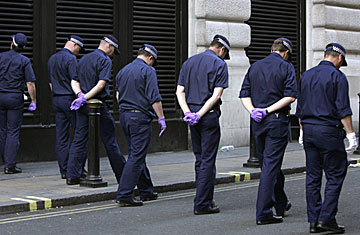
Police officers search a street around Haymarket, London, where a vehicle containing an explosive device was found, Friday, June 29, 2007.
Neither rain nor a light drizzle of updates from Scotland Yard on police efforts to prevent further terrorist attacks in London have deterred revellers from taking part in today's gay pride march or chased the capital's summer visitors indoors, and tomorrow's tribute concert for Princess Diana is set to proceed as planned. Only the tennis tournament at Wimbledon has been interrupted — but by the bad weather and not alarm over safety (though a still mysterious incident late Saturday afternoon in Glasgow, Scotland, where a car crashed into an airport terminal and apparently exploded into flames, has heightened security concerns). London is reacting with its usual sangfroid to its latest brush with terrorism. A plot to bomb central London was foiled yesterday, not by police or the security services but by one of the world's most effective counter-terrorism agents: luck. Ambulance attendants called to treat someone taken ill in the nightspot Tiger Tiger noticed that a metallic green Mercedes parked just outside the club had filled with smoke. They went to investigate, assuming this must be a vehicle fire.
Once the doors were opened, the smoke cleared to reveal something much more sinister-a device fashioned from gasoline, gas canisters and nails that, according to Deputy Assistant Commissioner Peter Clarke, the head of Scotland Yard's counter-terrorism command, could have caused "significant injury or loss of life" had it detonated.
The bomb was made safe and its constituent parts taken away for forensic analysis. Later, a second device was found, in a car pound in Park Lane that is overlooked by some of London's swankiest hotels. Traffic police had towed a second Mercedes, illegally parked near Tiger Tiger, to the pound early yesterday morning. The cars will provide ample forensic evidence but for now the facts of the case remain enveloped in a smog of speculation and confusion. Early reports that the driver had crashed the first car into a trash can outside Tiger Tiger, then abandoned the vehicle, have still not been confirmed by officials, but a manhunt is underway to find the drivers of both vehicles. A clear image of the man who ran from the first car is said to have been captured on CCTV. The plotters' affiliations are unknown but Scotland Yard's Clarke said that yesterday's events "resonated with previous plots."
Last year, a British-born Muslim convert named Dhiren Barot was sentenced to 40 years in jail for plotting attacks on the U.K. A 39-page list of possible targets and methods that Barot prepared for his al-Qaeda contacts included a plot he dubbed the Gas Limos Project. This proposed using propane gas cylinders and fuel to turn stretch limos into mobile bombs that could then be left in parking lots underneath key buildings.
The trial earlier this year of a group of British terrorists ensnared by the security services in an operation dubbed Crevice revealed some of the conversations between members of the group, who plotted to use fertilizer bombs against targets in Britain, including another London nightclub called the Ministry of Sound. This wasn't simply selected as a soft target, but as an emblem of Western corruption. "No one can even turn around and say 'Oh they were innocent, those slags dancing around,'" said one of the conspirators during a discussion recorded by the security services.
The British media have quoted unnamed police sources saying that the bomb could have caused "carnage" if it had detonated, but it's still far from clear how effective it would, in fact, have been. In 2002, bombers in Bali killed 200 night-clubbers and wounded hundreds more by detonating two separate devices, one to draw curious onlookers and a second that exploded in the midst of the assembled crowd. Dr. Peter Neumann, the director of the Centre for Defence Studies at King's College, London, told TIME that, based on the limited information available about the London car bombs, he didn't think they could have brought down a building, not least because the devices would have been too small. "In the 1993 World Trade Center bombing, there you had a huge truck loaded with explosives parked under the World Trade Center, so much better placed, and a much better load. And it still didn't bring down the World Trade Center."
A British security official confirms to TIME that there was no prior intelligence of any attack, although the security services are currently monitoring 1,600 individuals involved in terrorist activity, 200 networks and 30 plots. The source says investigators are keeping an open mind about the identity and motive of the bomber. Britain's current terrorism threat level has been deemed "severe" since the plot to bomb trans-Atlantic jets was uncovered last August. That means an attack is thought highly likely.
On his second day as Prime Minister, Gordon Brown warned Britons, "We face a serious and continued security threat to our country," and his new Home Secretary, Jacqui Smith, has already twice chaired the government's emergency response committee, Cobra. As investigators hurry to try to sift fact from a distracting mess of theories, they'll hope that Agent Luck remains on their side.
